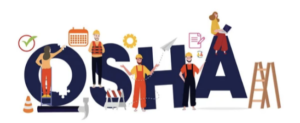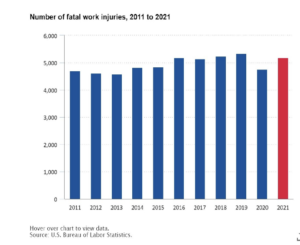All employers know (or should know) that OSHA may impose penalties on their companies for violations found
by its code compliance officers pursuant to the OSH Act of 1970. The Act establishes that regulations,
requirements, and standards administered by OSHA are not voluntary, but mandatory,
and that the agency has authority over all private sector working
all private sector working
conditions, with some exceptions, that are not covered by safety
and health regulations of another Federal agency under other legislation.
Perhaps less commonly known is OSHA’s ability under Section 17
(e) of the Act to charge an employer criminally for what it calls
willful violations, which it defines as a situation in which the employer
either knowingly failed to comply with a legal requirement (purposeful disregard) or acted with plain indifference
to employee safety which causes one or more worker fatalities.
For example, in this fictitious scenario, an employer ignores a prior OSHA order requiring the company to
implement control of hazardous energy protocols (lockout tagout) on a specific machine and subsequently an
employee dies while servicing it. OSHA may consider the employer’s non-compliance to be criminal misconduct.
The agency also has authority to bring criminal charges against an employer for providing advanced notice of an
OSHA inspection or for making false statements on any documents that are required by the Act.
What is the next possible step in this scenario? The agency asks the US Attorney having jurisdiction to file a
complaint in Federal Court where the case would be heard. If the employer is found guilty, penalties provided
by the statute include a fine of not more than $10,000 or imprisonment for not more than six months, or both,
for the first offense.
This is not the only course of action OSHA may take, however. The agency also may request that the local
District Attorney (DA) review the case and, if accepted on its merits, the employer could face far more serious
penalties than those available to OSHA in Federal Court. A DA has a considerable range of options under state
laws, including filing misdemeanor, felony, or even manslaughter, charges.
For example, in 2019 in Granby, Colorado, the DA brought manslaughter charges against the owner of a
company for the death of an employee in a trench for deliberate (willful) indifference to actual knowledge of the
significant risks associated with the trench work then failing to take action to prevent the fatality.
Granted, OSHA historically has resorted to appealing to District Attorneys only when egregious or flagrant
circumstances exist, but employers should be aware that a prison sentence, a hefty fine, or both, could be their
fate if OSHA proves that they had knowledge of the risks involved when employees perform a specific task or
tasks but did not act to protect them, resulting in a fatality. The best policy to avoid this type of jeopardy is to
establish and maintain a solid safety program and follow every OSHA regulation to the letter.
Workplace Fatalities Increase Again
The worst-case scenario for an employer is a worker’s death, which, besides being a human tragedy, also is a
total failure of the company safety program and their responsibility to provide a safe and healthful workplace.
Unfortunately, dying while on the job is not declining, despite significant advances in occupational safety
strategies, programs, and technology in the last ten years.
On Dec. 16, 2022, the U.S. Bureau of Labor Statistics (BLS) released its fatal occupational injuries report for
2021, and the results reveal an alarming spike of 8.9% compared to 2020. A BLS graph (see below)
illustrates the year’s ranking as compared to the previous ten years:

Even conceding that 2020 should not be used as a fair comparison
to 2021 due to the COVID-19 pandemic is not enough to lessen the
significance or explain this trend. Since 2011, the number of deaths
each year has been variable but with notable increases since 2016.
In 2021, fatalities were up once again, with 5,190 deaths, putting
this year in the number three spot behind 2018 (5,250) and 2019
(5,333). Moreover, the fatal work injury rate in 2021 is the highest
since 2016 with both years ending with a rate of 3.6 deaths per
100,000 full-time equivalent (FTE) workers.
.
Some of the highlights of the 2021 BLS report are
listed below:
Fatalities due to violence and other injuries by persons or animals increased to 761 fatalities in 2021
from 705 fatalities in 2020 (7.9 percent). The largest subcategory, intentional injuries by person,
increased 10.3 percent to 718 in 2021.
June 7, 2013 Vol #1 Issue #
1
HAMOND GROUP June 2023
Exposure to harmful substances or environments led to 798 worker fatalities in 2021, an increase of
almost 19 percent from 2020. This was the largest increase of any category and holds the record for
highest total since statistics were first collected in 2011. Unintentional overdose from nonmedical use
of drugs or alcohol accounted for 58.1 percent of these fatalities (464 deaths), up from 57.7 percent of
this category’s total in 2020.
Work related fatalities due to falls, slips, and trips increased 5.6 percent in 2021, from 805 fatalities in
2020 to 850 in 2021. Falls, slips, and trips in construction and extraction occupations accounted for 370
of these fatalities in 2021, and an increase of 7.2 percent from 2020 when there were 345 fatalities.
There was a 16.3-percent increase in deaths for driver/sales workers and truck drivers which went up
to 1,032 deaths in 2021 from 887 deaths in 2020.
Suicides continued to trend down, decreasing to 236 in 2021 from 259 in 2020, a decrease of 8.9
percent.
In the aftermath of this report’s release, reaction from safety advocacy groups was predictable. “The data
included in this report indicate workplaces have become less safe, and it is heartbreaking,” said Lorraine
Martin, president, and CEO of the National Safety Council said in a news release dated December 16, 2022.
“Everyone deserves the chance to live their fullest life. This report shows our mission to save lives, from the
workplace to anyplace, is critical…”.
“We know that most deaths on the job are preventable through common sense employer programs. Under the
law, employers are responsible for maintaining a safe workplace. During the COVID-19 pandemic, we saw the
prominent impact of workplace safety on our lives,” said AFL-CIO President Liz Shuler in a news release dated
December 16, 2022
The 2021 BLS analysis is disturbing news for safety professionals, regulators, and employers who have moral,
legal, and ethical obligations to prevent occupational fatalities. These sobering statistics indicate that despite
significant advances in occupational safety-related strategies, programs, and technology in the last ten years, it
is evident that much more work needs to be done. The lack of meaningful progress in preventing occupational
fatalities should be reason enough for all stakeholders to reevaluate their accident and illness prevention
programs because complacency is the enemy of progress.
________________________________________________________________
June 7, 2013 Vol #1 Issue #
1
HAMOND GROUP June 2023
Hamond Safety Management
Our Experience staff of loss control professionals can assist you in controlling workers
compensation cost by providing a wide range of services for reducing workplace
injuries. Our staff is available always to address the following workplace concerns:
Assistance in resolving company and worksite safety issues
Develop and provide customized company safety programs
Assistance in updating existing safety manuals for OSHA compliance
Safety Audits
Assistance in Recordkeeping & Related Items
Worksite & Shop Hazard Assessment service
Emergency Preparedness & Implementation
PPE Program Implementation
New Employee Safety Orientation
Fleet Safety Review
Confined Space awareness training
Forklift Safety Certification
Lockout/Tagout Review & Training
Noise Level/Hearing Conservation Testing
Employee certification for the new Hazard Communication Standard
Safety presentations for company safety meetings
Participations in worksite safety talks
Representation for the N.Y.S. ICR-59 program (if required)
Site-specific Safety manuals
Development of Corporate Safety Manuals
OSHA 10hr Safety Class (at your place of business)
Please direct any questions or concerns to:
The Safety Division at Hamond Safety Management
Anthony Vacchio, avacchio@hamondgroup.com 516-762-4224